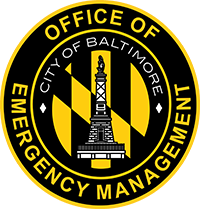

OEM manages a multi-faceted preparedness program comprised of planning, systems implementation, training, exercises, and evaluation.
OEM’s operational role is to coordinate interagency response and recovery. OEM implements systems and programs to enhance and integrate the City’s response to major incidents.
Working with other City agencies and outside experts, OEM studies the natural and human-caused hazards (threats) that have the potential to impact Baltimore. OEM evaluates the frequency and magnitude of different hazards, as well as the City’s inherent vulnerabilities to each, to arrive at an overall assessment of risk.
You can find information about different hazards on our Hazards page.
Based on its risk analysis, the City develops and implements long-term mitigation strategies. Mitigation consists of sustained activities that reduce the loss of life and property due to the occurrence of hazards. Mitigation measures include land use regulations, building codes, floodproofing, and stormwater management.
The Baltimore City Department of Planning has the overall responsibility for floodplain management in the City. Floodplain management is a community program of corrective and preventive measures for reducing future flood damage. These measures generally include zoning, subdivision, building requirements, and special-purpose floodplain ordinances.
 All-Hazards Response & Recovery Planning
All-Hazards Response & Recovery PlanningThe City practices an all-hazards, capabilities-based approach to emergency management. This entails building and organizing resources according to groups, known as Emergency Support Functions (ESFs). Each ESF represents a service or set of services that are likely to be required during a wide range of incidents. The City aims to continually enhance resources and planning for each ESF, thereby increasing preparedness for all hazards.
The City’s primary response and recovery plan are known as the Emergency Operations Plan (EOP). It consists of a basic plan, annexes for each ESF, and annexes for each hazard. The EOP is coordinated with and/or incorporates by reference all other plans, policies, and procedures that pertain to emergency response and recovery in the City. OEM maintains the EOP and works with numerous City agencies and outside organizations to develop and update sections of the Plan.
OEM’s all-hazards planning includes a focus on the City’s most vulnerable residents. OEM works with an array of partner agencies to develop plans and deliver training that meets the needs of all citizens. Among other activities, OEM chairs an Emergency Preparedness & Response Committee of the Mayor's Commission on Disabilities. Through all of these efforts, OEM aims to increase the disaster resilience of the people with special needs and the organizations that serve them.
 Continuity of Operations Planning
Continuity of Operations PlanningOEM also coordinates the City’s Continuity of Operations Plan (COOP). This Plan provides a management framework and establishes procedures to prevent disruption of essential services provided by the City. COOP consists of strategies to sustain essential activities in case of disaster or disruption and guides the restoration of the City’s daily functions.